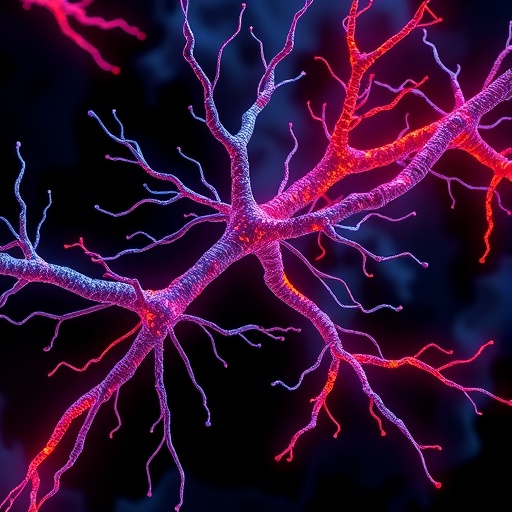In a groundbreaking study that promises to reshape our understanding of neural development and maintenance, researchers have uncovered a pivotal molecular mechanism that governs the interaction dynamics between neurons and glial cells. This discovery, detailed in a recent publication in Nature Communications, centers on the role of the guidance cue SEMA3B in orchestrating a critical switch from axon-axon to axon-glia interactions. Such a switch is not merely a cellular curiosity but a fundamental process necessary for the envelopment and structural integrity of unmyelinated axons — nerve fibers that lack the protective myelin sheath yet perform essential functions throughout the nervous system.
Neural circuits rely heavily on precise cellular interactions to maintain their architecture and function. Most research has focused on myelinated axons, which are insulated by myelin layers and crucial for rapid signal conduction. However, unmyelinated axons, despite lacking these sheaths, play essential roles in signal transduction, especially in the peripheral nervous system and within fine-scale neural networks in the brain. The mechanisms ensuring their proper envelopment and stability have remained elusive until now. The novel findings by Liu, Gao, Niu, and colleagues illuminate how SEMA3B drives a fundamental transition in the cellular microenvironment that safeguards these axons.
At the heart of the research lies the semaphorin family of proteins, known for their roles as molecular guidance cues during neural development. Semaphorins traditionally guide axon pathfinding and influence synaptic connections by mediating repulsive and attractive signals. SEMA3B, in particular, has emerged as a multifunctional player that goes beyond simple directional cues. The study reveals how SEMA3B dynamically modifies cellular interactions within the axonal niche to promote the establishment of axon-glia contacts, effectively replacing prior axon-axon adhesion once development reaches a maturation phase necessitating axonal envelopment.
.adsslot_kj7uGWNcgV{ width:728px !important; height:90px !important; }
@media (max-width:1199px) { .adsslot_kj7uGWNcgV{ width:468px !important; height:60px !important; } }
@media (max-width:767px) { .adsslot_kj7uGWNcgV{ width:320px !important; height:50px !important; } }
ADVERTISEMENT
The researchers employed an array of sophisticated techniques including high-resolution in vivo imaging, loss- and gain-of-function genetic models, and biochemical assays to dissect the temporal and spatial regulation of SEMA3B and its downstream signaling pathways. Their data indicate that during early neural circuit assembly, unmyelinated axons preferentially form homotypic adhesions with neighboring axons, likely contributing to fasciculation and guidance consistency. However, as neurons progress to maturity, SEMA3B expression increases in the local environment, triggering the dismantling of axon-axon contacts and simultaneously enabling glial processes to tightly associate with and envelop the unmyelinated axons.
This switch from axon-axon to axon-glia interactions is not just a rearrangement of cellular contacts but has profound implications for the maintenance of axonal integrity. Unmyelinated axons are particularly vulnerable to mechanical stress and metabolic insults due to the absence of myelin protection. The close association with glial cells, facilitated by SEMA3B signaling, provides necessary trophic support and structural reinforcement. Moreover, the envelopment processes mediated by glia may regulate excitability and signal conduction fidelity, further showcasing the critical nature of this interaction switch.
Mechanistically, the researchers uncovered that SEMA3B exerts its effects through receptor complexes involving neuropilins and plexins on the axonal and glial membranes. Activation of these receptors initiates intracellular cascades that reconfigure cytoskeletal elements, effectively modulating adhesion molecule dynamics. Key players such as cadherins and integrins, which mediate cell-cell adhesion, are differentially regulated after SEMA3B engagement, favoring axon-glia adhesion over axon-axon binding. This fine-tuning underscores the exquisite molecular coordination required to transition the axonal microenvironment from one dominated by neuron-neuron interactions to one supported by neuron-glia cooperation.
The study’s findings also open new avenues to understand pathological conditions characterized by peripheral neuropathies or central nervous system disorders involving unmyelinated axons. Aberrant SEMA3B signaling or failures in the axon-glia interaction transition could underlie certain neurodegenerative processes, impairing axonal integrity and function. Thus, targeting this pathway might offer novel therapeutic strategies to protect vulnerable neuronal populations or enhance regeneration after injury.
From a developmental biology perspective, the timing of the SEMA3B-induced switch offers insight into how neural circuits balance connectivity and plasticity. Early axon-axon adhesions facilitate accurate pathfinding and bundling during rapid outgrowth. Subsequently, initiating axon-glia envelopment preserves axonal stability and promotes the functional maturation of circuits. This temporal coordination likely contributes to optimizing signal propagation and resilience, especially within sensory modalities that depend heavily on unmyelinated fibers, such as pain and temperature sensation.
The authors discussed how disruptions in this signaling axis could manifest in clinical symptoms. For example, sensory deficits observed in certain neuropathies might reflect compromised axon-glia interactions, resulting in axonal degeneration. Likewise, the study raises questions about how SEMA3B expression is regulated in physiological and pathological contexts, including injury response and aging. Understanding these regulatory mechanisms is critical for translating basic findings into clinical applications.
Additionally, the detailed mapping of receptor activation and downstream pathways in various cell types provides a molecular framework that other researchers can build upon. This includes further exploration of how different semaphorin family members may coordinate with SEMA3B or compensate for its function under various conditions. Such knowledge expands the conceptual landscape of neuroglial interactions and opens possibilities for refined manipulation in experimental and therapeutic settings.
The study’s multi-disciplinary approach leverages genetics, molecular biology, advanced imaging, and electrophysiology to present a holistic picture of the axon-glia interaction switch. This integration of methods exemplifies a new standard in neuroscience research, where dissecting molecular signaling is tightly linked with cellular behaviors and physiological outcomes. The clarity with which the authors illustrate the consequences at every level — from molecules to organism — positions the work as a landmark contribution.
Future directions inspired by this research will likely delve deeper into the temporal dynamics of SEMA3B expression, its interplay with other guidance molecules, and the potential compensatory mechanisms in the nervous system. Moreover, investigating how glial subtypes differentially respond to SEMA3B signals might uncover specialized roles and mechanisms, adding further complexity and nuance to the neural microenvironment paradigm.
In summary, Liu and colleagues have identified a crucial molecular switch mediated by SEMA3B that redefines how unmyelinated axons interface with their environment, transitioning from homotypic axon-axon interactions toward supportive axon-glia envelopment crucial for axonal integrity. Their findings open novel horizons for basic neuroscience and clinical neurobiology, emphasizing the indispensable role of glial engagement in maintaining neural circuit functionality beyond the classical scope of myelination.
This advance not only bridges significant gaps in our understanding of nervous system architecture but also heralds new research avenues into neuroprotection, regeneration, and sensory biology. As the neuroscience community continues to unravel the intricate dance between neurons and glia, studies such as this underscore the importance of molecular signaling in orchestrating cellular partnerships vital for health and recovery.
Subject of Research: The molecular mechanisms by which SEMA3B regulates the shift from axon-axon to axon-glia interactions necessary for the envelopment and integrity of unmyelinated axons.
Article Title: SEMA3B switches axon-axon to axon-glia interactions required for unmyelinated axon envelopment and integrity.
Article References: Liu, L., Gao, Z., Niu, X. et al. SEMA3B switches axon-axon to axon-glia interactions required for unmyelinated axon envelopment and integrity. Nat Commun 16, 5433 (2025). https://doi.org/10.1038/s41467-025-61318-8
Image Credits: AI Generated
Tags: axon-axon to axon-glia switchcellular interactions in neural developmentglial cell function in nervous systemimportance of glial cellsmechanisms of axon stabilityNature Communications publication on neural maintenanceneural circuit architecture maintenanceresearch on unmyelinated axonsSEMA3B molecular mechanismSEMA3B role in axon-glia interactionsignal transduction in peripheral nervous systemunmyelinated axon integrity





